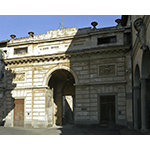Villa La Quiete - Farmacia dell'ex Conservatorio delle Montalve [Villa La Quiete - Pharmacy of the former Montalve Conservatory]
Villa La Quiete, so called for the fresco La Quiete che domina i venti (The quiet that overcomes the winds) (1633) by Giovanni da San Giovanni, is the result of a succession of enlargements and aggregations that took place from the 16th through the 19th century, when the villa was doubled in size by the construction of two new wings and the enclosure of the second courtyard. Bought in 1593 by Pier Francesco de' Medici, it was, under Cosimo I, the headquarters of the Commendators of the Order of Saint Stephen. In 1627, when Christine of Lorraine became its owner, the villa attained its highest splendour. Grand Duke Ferdinand II de' Medici then granted it to Eleonora Ramirez di Montalvo, who in 1650 designated it as a country retreat for the Congregation she had established, the Montalve, an institution for the education of young girls from noble families. In 1724 Anna Maria Luisa, the last descendent of the Medici family, moved to La Quiete and created there a formal Italian garden, for which she requested the consultation of Sebastiano Rapi, gardener of Boboli. On that occasion a new duct was built to bring water to the Fonte delle Lepricine. The Italian garden, with its geometric flower beds and wealth of fountains, is separated by a lemon-house from the ragnaia, a grove of ilex trees used for hunting or resting in the shade during the hot summer months, which in the 19th century was transformed, to the project of Giuseppe Poggi, into a park rich in both native and exotic plants.
On the ground floor of the Conservatory is the historic pharmacy. It is not certain whether it was built contemporaneous with the foundation of the Institute or at a later time, although some objects in its equipment dating from the late 17th century suggest that it was active already at that time. With the suppression of the Institute in Napoleonic times, its activity came to an end. Its furnishings, consisting of a set of glass-fronted cabinets and a counter with marble top, are distinguished by the simplicity of the ensemble, with very few decorative elements. The ceramic and glassware objects are interesting insofar as they bears witness to the activity carried out from the late 17th to the early 19th century. They consists of several round bowls with lids, albarellos, white ceramic jars, urn-shaped jars and others vessels of Doccia manufacture.
Today the villa is the seat of the Cultural Centre for Foreigners, under the authority of the University of Florence.
****************************
Texts by Graziano Magrini
English translation by Catherine Frost
Last update 11/gen/2008




